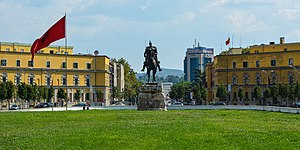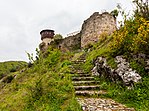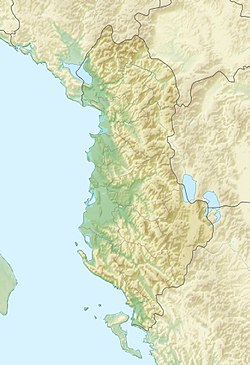ติรานา
ติรานา | |
|---|---|
เทศบาล | |
| พิกัด: 41°19′44″N 19°49′04″E / 41.32889°N 19.81778°E | |
| ประเทศ | |
| ภูมิภาค | กลาง |
| เทศมณฑล | ติรานา |
| ก่อตั้ง | ค.ศ. 1614 |
| การปกครอง | |
| • ประเภท | รัฐบาล |
| • นายกเทศมนตรี | เอรีออน เวลีอาย (พรรคสังคมนิยม) |
| • ประธานสภา | อัลดริน ดาลีปี |
| พื้นที่ | |
| • เทศบาล | 1,110.03 ตร.กม. (428.58 ตร.ไมล์) |
| • เขตเมือง | 41.8 ตร.กม. (16.1 ตร.ไมล์) |
| ความสูง | 110 เมตร (360 ฟุต) |
| ประชากร | |
| • ความหนาแน่น | 502 คน/ตร.กม. (1,300 คน/ตร.ไมล์) |
| • เทศบาล | 557,422[1] |
| • มหานคร | 906,166[2] |
| เดมะนิม | ติรานัส (ชาย) ติราเนส (หญิง) ติรอนส์ (ชาย) ติรอนเซ (หญิง) (สำเนียงท้องถิ่น) |
| เขตเวลา | UTC+1 (เวลายุโรปกลาง) |
| • ฤดูร้อน (เวลาออมแสง) | UTC+2 (CEST) |
| รหัสไปรษณีย์ | 1001–1028, 1031 |
| รหัสพื้นที่ | 04 |
| ทะเบียนรถ | TR |
| HDI (2018) | 0.818[3] – สูงมาก · อันดับที่ 1st |
| เว็บไซต์ | เว็บไซต์อย่างเป็นทางการ |
ติรานา (แอลเบเนีย: Tirona) เป็นเมืองหลวงและเมืองใหญ่สุดทั้งในแง่ของประชากรและพื้นที่ของประเทศแอลเบเนีย นครตั้งอยู่ทางตอนกลางประเทศโดยมีภูเขาดัยต์ตั้งอยู่ทางทิศตะวันออกและมีหุบเขาซึ่งตั้งอยู่ใกล้กับทะเลเอเดรียติกทางทิศตะวันตกเฉียงเหนือ เนื่องจากนครตั้งอยู่บนที่ราบติรานาและอยู่ใกล้กับทะเลเมดิเตอร์เรเนียน นครจึงได้รับอิทธิพลของภูมิอากาศแบบเมดิเตอร์เรเนียน ติรานาถือเป็นหนึ่งในนครที่มีฝนตกและมีแสงแดดมากที่สุดของทวีปยุโรป โดยมีชั่วโมงที่พบแสงแดดปีละ 2,544 ชั่วโมง[4][5]
ติรานาถูกจัดตั้งเป็นนครใน ค.ศ. 1614 แต่พื้นที่ของนครในปัจจุบัน มีเผ่าอิลลีเรียเข้ามาตั้งถิ่นฐานตั้งแต่ยุคเหล็ก ต่อมาได้ถูกชาวโรมันยึดครองและกลายเป็นส่วนหนึ่งของจักรวรรดิโรมันภายหลังจากสงครามอิลลีเรีย แหล่งมรดกสำคัญในยุคนั้นที่ยังปรากฏในปัจจุบันคือบ้านโมเสกแห่งติรานา ต่อมาในคริสต์ศตวรรษที่ 5–6 โบสถ์พาลีโอคริสเตียนได้ถูกสร้างขึ้นบริเวณแหล่งมรดกนั้น
หลังจากที่จักรวรรดิโรมันถูกแบ่งออกเป็นตะวันออกและตะวันตกในคริสต์ศตวรรษที่ 4 จักรวรรดิไบแซนไทน์ได้เข้ามาครอบครองพื้นที่นี้และสร้างปราสาทเปเตรเลในรัชสมัยจักรพรรดิยุสตินิอานุสที่ 1 นครถูกปล่อยปะละเลยอย่างไร้ความสำคัญเป็นระยะเวลานาน จนกระทั่งในคริสต์ศตวรรษที่ 20 รัฐสภาลุชเยได้ประกาศให้ติรานาเป็นเมืองหลวงของประเทศหลังจากที่แอลเบเนียประกาศอิสรภาพใน ค.ศ. 1912
ปัจจุบัน ติรานาเป็นศูนย์กลางด้านเศรษฐกิจ การเงิน การเมือง และการค้าที่สำคัญของประเทศ เนื่องจากนครตั้งอยู่ในภาคกลาง และมีการขนส่งรูปแบบต่าง ๆ ที่ทันสมัย ทั้งทางอากาศ ทางน้ำ ทางราง และทางถนน นครเป็นที่ตั้งของรัฐบาลแอลเบเนีย ซึ่งเป็นที่ทำการของประธานาธิบดี นายกรัฐมนตรี และรัฐสภาแอลเบเนีย นครได้รับรางวัลเมืองหลวงเยาวชนยุโรปประจำปี 2022[6]
อ้างอิง
[แก้]- ↑ "Profili i bashkisë Tiranë". 11 May 2015. คลังข้อมูลเก่าเก็บจากแหล่งเดิมเมื่อ 14 August 2017. สืบค้นเมื่อ 8 February 2018.
Popullsia: Sipas censusit të vitit 2011, në territorin e bashkisë së re Tiranë banojnë 557,422 banorë, ndërsa sipas Regjistrit Civil banojnë 757,361 banorë. Me një sipërfaqe prej 1,110.03 kilometrash katrorë, densiteti i popullsisë sipas të dhënave të Censusit është 502 banorë/ km2 ndërsa sipas Regjistrit Civil, densiteti është 682 banorë km2.
- ↑ "Popullsia e Shqipërisë" (PDF). instat.gov.al (ภาษาแอลเบเนีย). 1 January 2018. คลังข้อมูลเก่าเก็บจากแหล่งเดิม (PDF)เมื่อ 2020-07-06. สืบค้นเมื่อ 2020-07-04.
- ↑ "Subnational Human Development Index (2.1)". hdi.globaldatalab.org (ภาษาอังกฤษ). Global Data Lab.
- ↑ "Sunniest Cities in Europe". currentresults.com. p. 1.
- ↑ "European Cities With the Wettest, Rainiest Weather". currentresults.com. p. 1.
- ↑ "Congratulations, Tirana! Winner of the European Youth Capital for 2022". youthforum.org (ภาษาอังกฤษ). European Youth Capital. 21 November 2019. คลังข้อมูลเก่าเก็บจากแหล่งเดิมเมื่อ 2020-10-06. สืบค้นเมื่อ 7 December 2019.
หนังสืออ่านเพิ่มเติม
[แก้]- Akkam, Alia (13 October 2017). "The Capital of Albania Has Transformed into a Lively, Affordable Destination". Vogue.
- Hillsdon, Mark (27 February 2017). "The European capital you'd never thought to visit (but really should)". The Telegraph.
- Crevar, Alex (28 August 2015). "Tirana, Breaking Free From Communist Past, Is a City Transformed". The New York Times.
- Blocal, Giulia (16 September 2014). "Tirana's colorful buildings". Blocal Travel blog.
- Williams, Sean (11 July 2014). "Tirana fights to beat its addiction to cars and get its residents cycling". The Guardian. สืบค้นเมื่อ 12 July 2014.
- McRae, Hamish (13 September 2008). "Albania: Charmed by Tirana". The Independent.
- Abitz, Julie. Post-Socialist Development in Tirana. Roskilde: Roskilde Universitetscenter, 2006.
- Agorastakis, Michalis; Sidiropoulos, Giorgos (2007). "Population change due to geographic mobility in Albania, 1989–2001, and the repercussions of internal migration for the enlargement of Tirana". Population, Space and Place. 13 (6): 471–481. doi:10.1002/psp.463.
- Aliaj, Besnik; Keida Lulo and Genc Myftiu. Tirana: the Challenge of Urban Development, Tirana: Cetis, 2003 ISBN 99927-880-0-3
- Aliaj, Besnik. A Short History of Housing and Urban Development Models during 1945–1990, Tirana 2003.
- Bertaud, Alain. Urban Development in Albania: the Success Story of the Informal Sector, 2006.
- Bleta, Indrit. Influences of Political Regime Shifts on the Urban Scene of a Capital City, Case Study: Tirana. Turkey, 2010.
- Capolino, Patrizia (2011). "Tirana: A Capital City Transformed by the Italians". Planning Perspectives. 26 (4): 591–615. doi:10.1080/02665433.2011.601610.
- Felstehausen, Herman. Urban Growth and Land Use Changes in Tirana, Albania: With Cases Describing Urban Land Claims. University of Wisconsin-Madison, 1999
- Galeteanu, Emira. Tirana: the Spectacle of the Urban Theatre. MA Dissertation. Carleton University: Ottawa, 2006.
- Guaralda, Mirko (2009). Urban Identity and Colour : the Case of Tirana, Albania. Spectrum e-news, 2009(Dec), pp. 13–14.
- Jasa, Skënder. Tirana në shekuj: Terona, Theranda, Tirkan, Tirannea, Tirana: monografi, disa artikuj e materiale arkivore kushtuar historisë së Tiranës, Tirana 1997.
- Kera, Gentiana. Aspects of the Urban Development of Tirana: 1820–1939, Seventh International Conference of Urban History. Athens, 2004.
- Nase, Ilir; Ocakci, Mehmet (2010). "Urban Pattern Dichotomy in Tirana: Socio-spatial Impact of Liberalism". European Planning Studies. 18 (11): 1837–1861. doi:10.1080/09654313.2010.512169.
- Pojani, Dorina (2011). Mobility, Equity and Sustainability Today in Tirana, TeMA 4, no. 2, pp.99–109 เก็บถาวร 2019-12-10 ที่ เวย์แบ็กแมชชีน
- Pojani, Dorina (2010). "Tirana". Cities. 27 (6): 483–495. doi:10.1016/j.cities.2010.02.002.
- Pojani, Dorina (2011). "From Carfree to Carfull: the Environmental and Health Impacts of Increasing Private Motorisation in Albania". Journal of Environmental Planning and Management. 54 (3): 319–335. doi:10.1080/09640568.2010.506076.
- Pojani, Dorina (2011). "Urban and Suburban Retail Development in Albania's Capital After Socialism". Land Use Policy. 28 (4): 836–845. doi:10.1016/j.landusepol.2011.02.001.
- Alien by Alexandra Lewis, RTV Ora, Tirana, Albania, 2019, a TV series produced by domestic RTV Ora on life in Albania seen by a foreigner, Australian-born journalist Alexandra Lewis living in Tirana, Albania
แหล่งข้อมูลอื่น
[แก้]- Municipality of Tirana เก็บถาวร 2011-04-14 ที่ เวย์แบ็กแมชชีน
 . สารานุกรมบริตานิกา ค.ศ. 1911 (11 ed.). 1911.
. สารานุกรมบริตานิกา ค.ศ. 1911 (11 ed.). 1911.












